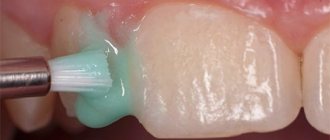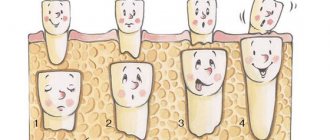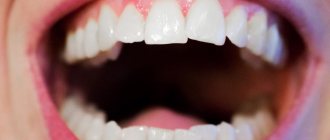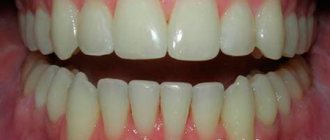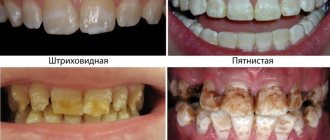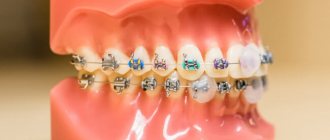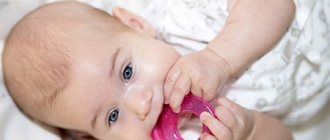What do crooked teeth look like in children?
Nature does not reward every child with an attractive and snow-white bite. A situation where a tooth comes in at an angle or extends beyond the general jaw arch is not uncommon. Sometimes it corrects itself as the child grows older, but this does not always happen, and there remains a risk that the back and front permanent teeth will grow crooked, similar to baby teeth.
To avoid this, you need to contact a pediatric dentist. Timely professional intervention in the problem in boys and girls will correct the malocclusion and prevent the development of possible complications.
Change process
The loss of baby teeth, as well as their appearance, is an individual process. Some children begin to lose teeth as early as five years of age, others after seven years of age.
This range is normal and should not cause concern to parents. Doctors note that in girls this process begins a little earlier than in boys.
Below is a table of approximate timing for the loss of baby teeth and the appearance of permanent teeth.
| Unit name | Loss (years) | Appearance (years) |
| Lower medial incisors | 5—7 | 6—7 |
| Upper medial incisors | 5—7 | 6—7 |
| Lateral lower incisors | 6—8 | 7—8 |
| Lateral lower incisors | 6—8 | 7—8 |
| Upper molars | 7—9 | 8—10 |
| Lower molars | 7—9 | 8—10 |
| Upper canines | 8—11 | 9—11 |
| Lower canines | 8—11 | 9—11 |
| Second lower molars | 7—10 | 10—13 |
| Second lower molars | 7—10 | 10—13 |
The order of change corresponds to the order of their appearance. On average, final replacement occurs at 12-13 years. This period can also be accompanied by various pathologies. The most common of which is the appearance of crooked teeth.
Modern dental plates and braces make it possible to successfully solve these problems; the main thing is to contact a specialist in a timely manner.
It should be noted that the condition of milk teeth is of great importance for the formation of healthy permanent teeth of the correct shape. Thus, untreated caries of primary teeth will contribute to infection of the permanent tooth buds, and a serious bruise of the temporary units can provoke the death of the permanent tooth bud, which will subsequently affect the formation of a correct bite and a beautiful smile.
A properly balanced diet is also of great importance in the formation of permanent teeth; children should eat more vegetables and fruits, as well as foods high in calcium.
Why do children's teeth grow crooked?
The main causes of abnormal tooth growth in childhood.
Dairy
Experts note that curvature of the primary bite is rarely observed. Even if the baby’s first teeth are not straight, a little later they usually fall into line and the smile looks more aesthetically pleasing. Moms and dads are more alarmed by the gaps between the milk units, but in most cases this is also normal.
Baby teeth are small, so they require less space in the jaw. The child’s jaw apparatus is constantly growing, which is why gaps appear between the dental elements. This is important for the formation of a future permanent dentition.
Causes of curvature of baby teeth:
- deficiency of vitamins and minerals in a woman’s diet during pregnancy;
- monotonous nutrition of a nursing mother and feeding of a baby, during which little calcium and fluoride enters the child’s body;
- insufficient load on the baby’s oral muscles, which contributes to underdevelopment of the jaw arches;
- chronic pathologies of the respiratory tract, against the background of which the child constantly breathes through the mouth;
- bad habits associated with prolonged use of a pacifier, thumb sucking, etc.;
- unfavorable heredity - if one or both parents have a problem with crooked teeth, there is a high probability that it will occur in their daughter or son.
Indigenous
Molars are often uneven, which is usually due to their uneven appearance as a result of changes in the primary dentition. The size of the erupted units remains with the person for the rest of his life, and it may differ from the milk elements. If the child’s jaw has not yet reached the optimal length that allows all the molar units to fit, they begin to shift and grow crookedly, sometimes even in two rows, if the milk precursor did not have time to change in time.
While the tooth is cutting, its pathological position may be temporary. The front upper permanent teeth often grow crookedly, but over time they manage to turn around and fit into the general jaw arch. But most often they remain crooked, requiring orthodontic intervention.
Recommendation No. 1. It is better to stop the problem at a very young age
The fact that the first baby teeth grow crookedly is often caused by incorrect or too slow formation of the jaw. And pathology is preceded by problems that occurred at the stage of fetal formation in the prenatal period (that is, during the woman’s pregnancy), or in the first years of the baby’s life. Therefore, orthodontists advise all women planning a pregnancy and raising children who are not yet one year old to take measures at these stages:
- the expectant mother needs to eat well, take vitamins, treat diseases and eliminate dental problems,
- It is preferable to feed a newborn with mother’s milk rather than formula: in order to receive nutrition from the breast, the baby strains certain parts of the maxillofacial apparatus, which contributes to their normal growth and development,
- if the baby is still on artificial nutrition, then it is necessary to purchase bottles with orthodontic tips: if the mixture flows freely into the mouth, then the baby does not make much effort, as a result of which the jaws develop poorly,
- Introduce solid foods in a timely manner. Some parents, for fear that the baby will choke or have indigestion, take a long time to puree vegetables, fruits and meat. As a result, the first teeth are left without work and begin to deform,
- do not cause ENT diseases: because of them, children begin to breathe through their mouths, incorrectly position the tongue, which ultimately affects the primary and permanent bites,
- diversify your child's daily diet (after 8 months) with foods rich in calcium, magnesium, phosphorus: there are many of them in fish, dairy products, cheeses, and herbs.
Breastfeeding has a positive effect on the development of a child's teeth
What to do if a child’s tooth grows crookedly
As soon as parents see that their child’s teeth are not growing properly, they need to visit a dentist. The specialist will examine the patient and determine the severity of the problem and possible ways to correct it.
There are many techniques that make it possible to correct uneven teeth in childhood:
- Braces. Treatment with fixed orthodontic appliances is carried out in children with deviated permanent dentition, most often in persons over 12 years of age. Adolescence was not chosen by chance - metal arches will not interfere with the active development of the jaws, which is noted at an earlier age. The installed device directs the dental elements in the desired direction, allowing you to achieve the effect of perfectly straight teeth. Duration of treatment is from 1 to 3 years.
- Records. Prescribed by an orthodontist for children over 7 years of age. Plates can correct a variety of problems, such as situations where the first molar is growing sideways or the lower incisors are overcrowded. The plates are removable or non-removable and are made individually; they have a metal arc and a locking mechanism. The archwire puts constant pressure on the growing crooked teeth and is used until each tooth falls into place. Treatment with plates lasts on average from 1 to 2 years.
- Trainers. They present an elastic silicone mouth guard that needs to be used at night while the child is sleeping. Initially, lighter and softer products are used; at the final stage of correction, they are replaced with a trainer made of a denser material. On average, the course of treatment lasts about 1 year, it is recommended for children from 6 to 8 years old.
Care
Sometimes parents are perplexed: it seems that they don’t give sweets, and the child consumes enough calcium-rich foods, but the first formations in the jaw are still susceptible to caries or destruction.
New teeth should be brushed from the moment they appear.
. At first, you can use a damp cloth or soft brush.
The paste should be exclusively for children; you must carefully read the instructions to determine at what age it can be used. The presence of fluorine and some other substances in the paste is very dangerous for a small organism.
Do not scrub too hard with the brush, as newborns are very sensitive. Cleaning is carried out in the morning, in the evening, and preferably after each feeding. It is advisable to have sweet snacks immediately after meals so that you can then cleanse your mouth.
It is especially important to cleanse before bed
, since less saliva is released at night, and pathogenic bacteria multiply faster, causing caries.
Under no circumstances should you leave your mouth overnight after eating sweet candy, juice or milk. The brush must be replaced every three months
and treated with soap or boiling water after each cleaning.
Mothers definitely need to know why a white coating appears on the tongue of a newborn and when to see a doctor!
We offer you ways to treat an abscess on a child’s gum.
Here: https://www.vash-dentist.ru/lechenie/bolezni-polosti-rta/kakovyi-prichinyi-povyishennogo-slyunootdeleniya.html - talks about possible causes of increased salivation (hypersalivation) in children.
Thus, as your baby’s teeth grow, the main thing is to be patient and take this significant event responsibly. Do not panic. In case of the slightest concern, it is better to consult a doctor to prevent possible problems in the future.
Be attentive to your baby, show him your love and confidence, and soon he will smile at you with a charming white-toothed smile.
What happens if you don't correct crooked teeth?
If a child develops crooked teeth, he or she must be shown to a doctor, since ignoring the situation can lead to the development of the following complications:
- Crooked baby teeth are highly likely to be replaced by similar permanent teeth in the future. After a pathological primary bite, the rudiments of the molars also begin to grow incorrectly at an angle.
- People with crooked teeth are more difficult to maintain good personal hygiene and are more likely to suffer from caries and other dental problems.
- Crooked children's teeth can constantly injure the gum mucosa, causing discomfort, periodontal disease and stomatitis.
- The chewing function suffers - with abnormally located dental units, a person cannot fully chew food, which affects the health of his gastrointestinal tract.
- Ugly teeth cause psychological discomfort and interfere with normal communication with peers.
- The risk of developing pathologies of the temporomandibular joint increases, which provoke headaches, tension and discomfort of the jaw, etc.
Features of the period of tooth growth
The rudiments of milk teeth begin to form in the womb. At approximately six months of age, they gradually cut through the soft tissues of the oral cavity, becoming visible. This time is quite difficult for the baby and his mother and father, because feeling significant discomfort, the child becomes capricious, his body temperature rises, and often refuses to eat. At the same time, adults are very concerned, they try to help the baby in every possible way, and often do not get enough sleep themselves.
Preventing crooked teeth
The organization of optimal conditions for the proper development of the jaws and the growth of the dentition should be carried out from an early age. Basic measures to prevent crooked teeth:
- timely treatment of ENT diseases;
- compliance with bottle feeding techniques during artificial feeding;
- refusal of long-term use of nipples and pacifiers;
- a ban on holding stationery in the mouth, weaning off the habit of biting nails;
- introduction of solid complementary foods from the moment the first baby teeth appear;
- maintaining daily oral hygiene - helps protect dental elements from caries and destruction, facilitating timely change of primary occlusion;
- maintaining the balance of vitamins and microelements in the child’s body for the optimal development of his skeletal system.
Important!
Starting from 2 years of age, it is recommended to visit the dentist once every 6 months. This will allow timely detection and correction of orthodontic defects in the child’s smile.
Order and sequence
The development of teeth in a child begins in the prenatal period. There is no clear time frame for when the first incisors should appear; this is as individual as the period of closure of the fontanel on the crown of the head, the weight and height of the child.
It happens that a newborn is born with 1-2 incisors, and it happens that the baby is blessed with the first jaw bone at 20 months. By the age of three, children can boast of twenty baby teeth. There is an opinion that genetic predisposition matters for the timing of the appearance of milk formations. However, this fact should not be taken as an axiom.
Table No. 1. “When children start cutting and losing teeth” - approximate timing
| Name | Teething, months | Loss, years |
| Central incisors | 0-12 | 6-7 |
| Lateral incisors | 9-16 | 7-8 |
| Fangs | 16-23 | 9-12 |
| Molars | 13-33 | 9-12 |
The following video outlines 3 main rules that you need to know when teething in babies:
Cost of teeth straightening
The cost of bite correction, for example, crooked lower front teeth, depends on the treatment method and the complexity of the diagnosis.
Trainers are included in the category of available devices. On average, the price for one product in clinics in Moscow and St. Petersburg ranges from 3 to 5 thousand rubles. To this amount you need to add the cost of consultation, selection of trainers and patient monitoring, so the total cost of correction can cost twice as much - from about 8 thousand rubles.
Correcting crooked teeth with removable plates will be cheaper than with fixed plates. In the first case, you need to pay from 5 to 10 thousand rubles for the structure, in the second - 1.5 - 2 times more. The final amount of treatment is influenced by the diagnosis and extent of orthodontic intervention.
Correction with braces is more expensive than other methods. Turnkey treatment in Moscow and St. Petersburg can cost from 80 thousand rubles. This amount includes the following:
- initial examination and selection of treatment regimen - 1000;
- diagnostic stage - from 500 to 4000;
- taking impressions - up to 2000;
- sanitation of the oral cavity - from 3000;
- the cost of a braces system for one jaw is from 25,000;
- installation of the structure - up to 15,000;
- system correction - from 300 rubles;
- removal of braces and restoration measures - from 15,000 rubles.
